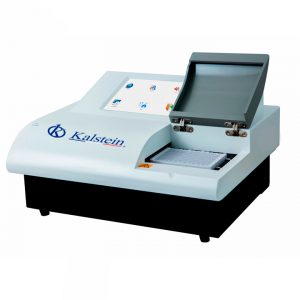In health companies, they perform laboratory practices with appropriate equipment for the detection of the Human Immunodeficiency Virus or well known as HIV, using special techniques such as ELISA or by its acronym in English Enzyme-Linked ImmunoSorbent Assay, or Assay for Enzyme-Linked Immunoabsorption.
This technique is performed for the detection of antigens by antibodies related to an enzyme, through some detectable product, manifesting color change, which induces measurement with the use of the Microplate Reader.
This instrument is important to know, among other things, if a patient has an autoimmune infection, and Kalstein has the ideal equipment, the Microplate Reader (ELISA), proves that it is the ideal for laboratory tests, where it verifies and certifies the adequacy of important processes and shows reliable results directed towards the diagnosis of diseases such as HIV.
Microplate Reader (ELISA) Functions
To carry out tests for the detection of autoimmune diseases, the Microplate reader using the ELISA technique is the equipment trained for such purposes, because it is designed to measure the amounts of light transmitted by the test for various wavelengths and have a tungsten illumination source with a level that expands from 400 nm to 700nm.
It also has mechanisms that separate the illumination spectrum and provide energy to a certain wave that must be calibrated periodically for when it does not comply with the measures to be carried out. A Microplate is rectangular in shape and approximately 12.5 cm by 8.5 cm also called pattern plates and have 96 wells in 8 rows and 12 columns, where each one symbolizes a value of absorbance to various wavelengths.
Enzyme-linked immunosorbent assays (ELISA)
For detecting HIV infections, adsorption enzyme immunoassay is usually the technique used for such practices because it is unlikely to show false results. The practice is based on the deduction that after adjusting feasible antigens to an insoluble solid power plant, they stop the immunological activity and that these biomolecules also manage to bind to an enzyme, stopping the results in both enzymatic and immunological agility.
However, its advantage is due to its high degree of comprehensibility, detectability, punctuality and precision, which makes practices according to the ELISA technique can be equipped to radioimmunoassays without errors.
On the other hand, this type of test has been improving because previously only certain antibodies could be detected and not as soon as it should be, while currently with the ELISA technique it is possible to generate tests for certain antibodies and even certain proteins of the virus itself in which they contain high levels in the blood during the first phase of the infection.
Importantly, these tests are usually the most effective for analysis with a number of samples daily, either in large blood banks or in surveillance studies. To do this, it requires an expert or technical user specialized in the maintenance of the equipment, in addition to a regular electricity supply, these being the most suitable for use in hospitals or small laboratories.
Microplate reader (ELISA) Kalstein mark
At Kalstein we are manufacturers of Microplate Readers, specialized to apply the ELISA Technique. It has the most advanced technology to make our customers feel satisfied and we have the best prices in the market. They belong to the YR series and have attractive features, such as 405nm, 450nm, 492nm, 630nm wavelength. Reading range 0.000-4.000 Abs. Match Level of ≤0.015th. Linearity of R > 0.999. In addition to a 10.4-inch color touch-sensitive LCD screen. Printing a complete report, including hospital and patient information and test results and a built-in, easy-to-use laptop.
If you want to enjoy many other features that our team has, we invite you to review our catalog from HERE
We invite you to visit the products from our HERE Before making your purchase, you will be advised by our experts to make your experience excellent.

